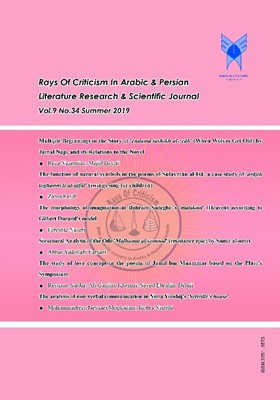Non-verbal communication analysis in the system "Srivily Home» Nima Youshij
Subject Areas : Literary criticismMohammadreza Neshaei moghaddam 1 , Koobra Nodehi 2
1 - Ph.D. student of Persian language and literature, Gorgan branch, Islamic Azad University, Gorgan, Iran.
2 - Assistant Professor
Keywords: symbol, Location, Serivili House System, non-verbal communication, message transmission, time position, Nima Yoshij,
Abstract :
The sign as a symbol is a concept that is derived from the movement of some human organs or spatial and temporal positions and is more important and effective than verbal communication in places. In order to establish a good relationship, it is necessary to co-operate with the components in which the coordination between them can show us an interpretable connection, and the role of non-verbal communication is very important. The aim of this study is to examine the Nima's symbolic view as an innovative poet and traitor in different communication platforms and to achieve different reactions and reactions to the audience. The research, descriptive and analytical show Nima Youshij System " Srivilys Home" through non-verbal communication to reinforce the message of your verbal and has managed it to your audience spread the use of signs of nonverbal communication As with environmental conditions, the color and state of the body in this system are more impressive and the use of these signs to emphasize and highlight the expression and in order to induce the desired concepts Nima.
أرجایل، مایکل. (1378ش). علم النفس ولغة الجسد فی عملیة التواصل. ترجمة مرجان فرجی. طهران: مهتاب للنشر.
پارسا، شمسی، محمدی، عباسقلی. (1389ش). «وجهة نظر نیما فی الوصف المستخدم فی قصیدته بیت السریویلی». فصلیة کاوش نامه. السنة 11. العدد 21. صص 25-12
پیس، باربارا وپیس، آلن. (1386ش). کیف نتحدّث بلغة الجسد.ترجمة آذر محمودی. ط2. طهران: إشارة للنشر.
جهانگیری، نادر. (1378ش). اللغة انعکاس للزمان، والثقافة والفکر (مجموعة مقالات). طهران: آگاه.
جلالی پندری، یدالله. (1394ش). مختارات شعریة لنیما یوشیج. طهران: دار مروارید.
حاجتی، سمیة. (1389ش). تحلیل التواصل غیر اللفظی فی قصص مصطفی مستور. رسالة ماجستیر. جامعة گیلان.
حسن لی، کاووس. (1386ش). أنواع الإبداع فی الشعر المعاصر الإیرانی. طهران: دار ثالث.
راودراد، أعظم. (1390ش). آراء فی علم الاجتماع الفن والأدب. طهران: دار نشر جامعة طهران.
رستم خانی، حمیدرضا. (1389ش). التواصل غیر اللفظی. طهران: أمیدان.
ریتشموند، فیرجینیا وجیمز سی مک کروسکی. (1388ش). السلوکیات غیر اللفظیة فی الاتصالات البشریة (ملخص التواصل غیر اللفظی). ترجمة فاطمة سادات الموسوی و ژیلا عبدالله پور، تحت إشراف غلامرضا آذری. طهران: دانژه للنشر.
فراتزوی، استیفان ال. (1386ش). علم النفس الاجتماعی. ترجمة مهرداد فیروز بخت. طهران: رسا.
کویلی، پول. (1387ش). نظریة التواصل. ترجمة شاهم صبار. المجلد الأول. ط1. طهران: مرکز الدراسات الثقافیة والاجتماعیة.
لوشر، ماکس. (1389ش). دلالات الألوان فی علم النفس. ترجمة ویدا ابی زاده. طهران: دار درسا للنشر.
میرأنصاری، علی. (1345ش). وثائق حول نیما یوشیج. طهران: مرکز المستندات الوطنیة.
یوشیج، نیما. (1375ش). المجموعة الکاملة لأشعار نیما یوشیج. باهتمام سیروس طاهباز. طهران: نگاه.
Gudykunst, William b, Stella thing Toomey, Elizabeth chua.calture and interpersonal communication. London: sage, 1998
Little,John,w.stephen.Theoreis of human communication. Canada:wad sworth publishing co, 1997
Ruby, jay
1996 visual anthropology
Encyclopedia of Cultural Anthropology
David Levinson and Melvin Ember, editors. New York: Henry Holt and Company, vol. 4:1345-1351
Stephen W. Littlejohn, Karen A. Foss "Encyclopedia of Communication Theory, Sage, 2009
_||_

